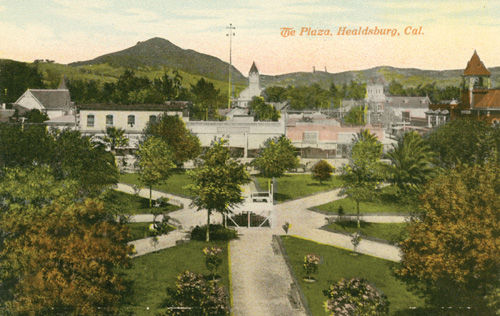New museum exhibit showcases long, varied history of Healdsburg’s Plaza
After delving into Sonoma County’s ties to the Civil War and exploring the nature of its 19th century utopian communities, the Healdsburg Museum & Historical Society will soon debut a new exhibit dedicated to its longstanding hub: the Healdsburg Plaza. “If the Plaza Could Speak,” running from August 14 through November 9, focuses on the history of the city through the context of the Plaza, which has served as an anchor for Healdsburg since its founding in 1857.
The exhibit shows that the Plaza has served as a microcosm of larger aesthetic and social changes that affected Healdsburg and beyond. The distinct personalities of varying time periods, as displayed through the wealth of photos and artifacts available to the Museum, highlight differences as slight as a preference for palm trees over gumdrop-shaped foliage, or more those extreme; in different periods, a prim women’s club and fountain-bathing bikers each held sway over the Plaza scene.
“I’m using the Plaza as this lens to look at the larger town,” said Holly Hoods, who is the curator of the Healdsburg Museum & Historical Society. “It’s kind of this community gathering place. Not only have there been all these festivals and parades that have been there – it’s also the place when a tragedy hits, that people come together. It’s just been an important place for Healdsburg.”
Grouped by eras, the exhibit stretches back to when the Plaza was established alongside Healdsburg in 1857. “Harmon Heald actually reserved a Plaza in the center of town and dedicated it to the city,” Hoods said. With the intent of developing the area into a wholesome space for community use, Heald reserved lots around the Plaza for churches. “He really didn’t want it to be taken over by bars and saloons – I don’t know how he’d feel about tasting rooms,” Hoods said.
Exhibit highlights also include a section devoted to the powerful Ladies’ Improvement Club, a group of women who were set on curtailing drinking in the Plaza through the dissolution of popular band concerts. “[The women] were not yet able to vote, but they wanted to do things in their town,” Hoods explained. Sought-after improvements included street lighting and labeling, though their crowning achievement came with their determination to exterminate the popular bandstand venue.
“Thousands of people would come to the Plaza and basically drink and listen to music,” Hoods said. Yet through their influence, the Ladies’ Improvement Club managed to obtain permission to tear down the bandstand in the early 1900s and erect a fountain in its place. “They actually tore down the bandstand. They erected this beautiful, tall 13-foot marble fountain,” Hoods said. “And the next day the people of Healdsburg built an even bigger bandstand right next to their fountain.”
The Plaza also bore witness to an economically depressed period in the 1970s. “The Plaza was basically surrounded by boarded-up buildings,” Hoods said. “A lot of the buildings were unoccupied and vacant. I feel like the Plaza has seen the rise and fall of the town.”
At that time, the fountain in the Plaza was a popular gathering spot for the Hells Angels club. “Think about how different that Plaza would be than the Plaza is today,” Hoods said. “In fact, they kind of took over that part of the Plaza. There would be biker chicks taking sponge baths in the fountain. It’s interesting to see, again, how much the life of the town is reflected in what happened in the Plaza.”
The exhibit also delves into the current prosperity of the Plaza and Healdsburg, Hoods said, concluding with a nod to recent accolades, including its place among “America’s Most Beautiful Town Squares,” according to “Travel + Leisure,” and a ranking among the “Best small towns to visit in 2014,” according to “Smithsonian” magazine.
Hoods said that the exhibit’s content also extends beyond historical photos and artifacts. A woodworker named Jon Lacaillade, who previously contributed his talents to the utopian community exhibit, is crafting a miniature reproduction of the Plaza as it appeared in 1886. In addition to the surrounding buildings, “He’s making buggies and wagons and all of the things that were on the Plaza at the time,” she said. Volunteer Maggie Bates is also sculpting figurines from modeling clay for use in the reproduction.
As with its previous exhibits, Hoods plans to supplement “If the Plaza Could Speak” with a free audio tour, which will become available a few weeks after the exhibit’s debut. The Museum works with professional voice-over narrator Elizabeth Holmes to develop the tours, though Hoods intends to have multiple narrators lend their talents to this exhibit, each voice representing a period in the Plaza’s varied history.
“I was thinking of ‘If the Plaza could speak’ as a good way to have a narrative that goes along with the audio tour as a way to tell stories,” she said. “When I do exhibits, I want to get a lot of history out there, but I want to try to do it in an entertaining and interesting way. And I thought it would be fun to try to have different people’s voices sort of talking as the Plaza at different times.”
“If the Plaza Could Speak” opens at the Healdsburg Museum & Historical Society on August 14 and runs through November 9. For more information, call 431-3325.









